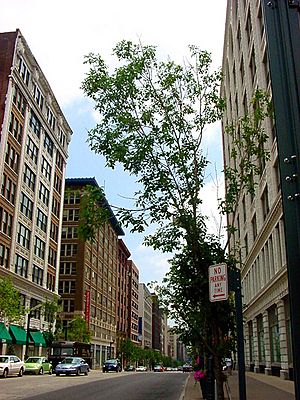History of St. Louis (1981–present) facts for kids
The history of St. Louis, Missouri from 1981 until now has seen many changes. The city worked to make itself more beautiful and safer. There was also a big court case about schools and efforts to improve downtown areas. St. Louis still faces challenges like crime and a shrinking population, but there have been some good changes in these areas too.
Contents
Making Schools Fair: The Transfer Program
Even though St. Louis Public Schools were officially desegregated in the 1950s, many Black families lived in specific areas because of old housing rules. This meant that schools often remained separated by race.
In 1971, a lawsuit was filed, saying that the city's schools were still segregated. After several court decisions, a plan was created in 1981. This plan aimed to fix the segregation by allowing Black students from the city to voluntarily transfer to suburban schools. The state of Missouri had to pay for transportation and other costs because it had laws that caused some of the original segregation.
How the Transfer Program Worked
To get suburban school districts to join, the court offered to remove them from the lawsuit. This encouraged many districts to participate. The agreement, signed in 1983, had several parts:
- Student Transfers: Suburban schools agreed to increase their Black student population.
- Magnet Schools: Students from the county could choose to transfer to special "magnet schools" in the city. These schools offered unique programs.
- School Improvements: Money was set aside to improve city schools.
- Funding: The state of Missouri paid for the program.
The program started in the 1983-1984 school year.
Challenges and Changes to the Plan
Some politicians, like John Ashcroft, who became the Governor of Missouri, opposed the plan because of its costs. Despite these challenges, the plan helped a lot. In 1980, most Black students in the city attended all-Black schools. By 1995, this number was much lower. By the late 1990s, about 13,000 students were part of the transfer program.
Later, other state leaders, like Jay Nixon, also questioned the program's cost. They suggested that money should be spent on improving city schools directly instead of on transfers. In 1999, a new agreement was made. It reduced state funding and focused on supporting magnet schools and the voluntary transfer program. Some suburban districts were allowed to leave the program after 2002.
The Program's Impact Today
Most of the desegregation happened with city students moving to suburban schools. While the plan hoped for more white students to come to city magnet schools, fewer did. As of 2010, about 6,000 city students transferred to suburban schools. The program also aimed to improve city schools, but their quality often remained lower than county schools. Some people also worried that the program took talented students away from city schools.
Despite these issues, the program will continue until all current transfer students graduate. The last group of students was allowed to enroll in 2013-2014, meaning the program will fully end after the 2025-2026 school year.
New Buildings and City Improvements
From 1981 to 1993, downtown St. Louis saw a lot of new construction. This was the most building activity since the early 1960s.
Key Downtown Projects
- One Metropolitan Square: This became the tallest building in the city.
- Union Station: Once a train station, it was reopened in 1985 as a popular place with shops and restaurants.
- St. Louis Centre: A large, four-story shopping mall opened in 1985. However, it became less popular over time and closed in 2006. Now, parts of it are being turned into apartments, a hotel, and shops.

The city also expanded the St. Louis Convention Center. Leaders worked hard to keep professional sports teams in St. Louis. They bought The Arena, which was home to the St. Louis Blues hockey team. Later, a new hockey arena, now called Enterprise Center, was built. It opened in 1994. The nearby Stifel Theatre (formerly Kiel Opera House) was also renovated and reopened in 2011.
Revitalizing Neighborhoods
Starting in the early 2000s, many old buildings in St. Louis were renovated, and new ones were built. The Washington Avenue Historic District saw a big change. Old factory buildings were turned into modern apartments called "lofts." This made the area much more popular and increased the number of people living downtown.
Other important downtown projects included:
- Old Post Office: This historic building was renovated and reopened in 2006. It now holds offices, a library branch, and a university branch.
- Roberts Tower: This was the first new residential building in downtown St. Louis since the 1970s.
Sports and Other Developments
The St. Louis Cardinals baseball team wanted a new stadium. In 2002, plans for a new Busch Stadium were approved. It opened in 2006. Next to it, a new area called St. Louis Ballpark Village was built, offering shops, restaurants, and entertainment. It was finished in 2014.
Other neighborhoods, like Forest Park Southeast, are also being improved. The National Geospatial-Intelligence Agency also opened a new location in North St. Louis.

